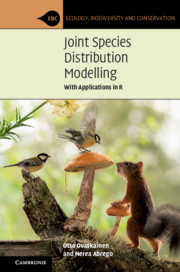Book contents
- Joint Species Distribution Modelling
- Ecology, Biodiversity and Conservation
- Joint Species Distribution Modelling
- Copyright page
- Contents
- Preface
- Acknowledgements
- Part I Introduction to Community Ecology
- Part II Building a Joint Species Distribution Model Step by Step
- 5 Single-Species Distribution Modelling
- 6 Joint Species Distribution Modelling
- 7 Joint Species Distribution Modelling
- 8 Bayesian Inference in HMSC
- 9 Evaluating Model Fit and Selecting among Multiple Models
- Part III Applications and Perspectives
- Epilogue
- References
- Index
9 - Evaluating Model Fit and Selecting among Multiple Models
from Part II - Building a Joint Species Distribution Model Step by Step
Published online by Cambridge University Press: 18 May 2020
- Joint Species Distribution Modelling
- Ecology, Biodiversity and Conservation
- Joint Species Distribution Modelling
- Copyright page
- Contents
- Preface
- Acknowledgements
- Part I Introduction to Community Ecology
- Part II Building a Joint Species Distribution Model Step by Step
- 5 Single-Species Distribution Modelling
- 6 Joint Species Distribution Modelling
- 7 Joint Species Distribution Modelling
- 8 Bayesian Inference in HMSC
- 9 Evaluating Model Fit and Selecting among Multiple Models
- Part III Applications and Perspectives
- Epilogue
- References
- Index
Summary
This chapter focuses on model evaluation and selection in Hierarchical Modelling of Species Communities (HMSC). It starts by noting that even if there are automated procedures for model selection, the most important step is actually done by the ecologist when deciding what kind of models will be fitted. The chapter then discusses different ways of measuring model fit based on contrasting the model predictions with the observed data, as well as the use of information criteria as a method for evaluating model fit. The chapter first discusses general methods that can be used to compare models that differ either in their predictors or in their structure, e.g. models with different sets of environmental covariates, models with and without spatial random effects, models with and without traits or phylogenetic information or models that differ in their prior distributions. The chapter then presents specific methods for variable selection, aimed at comparing models that are structurally identical but differ in the included environmental covariates: variable selection by the spike and slab prior approach, and reduced rank regression that aims at combining predictors to reduce their dimensionality.
Keywords
- Type
- Chapter
- Information
- Joint Species Distribution ModellingWith Applications in R, pp. 217 - 252Publisher: Cambridge University PressPrint publication year: 2020
- 1
- Cited by

